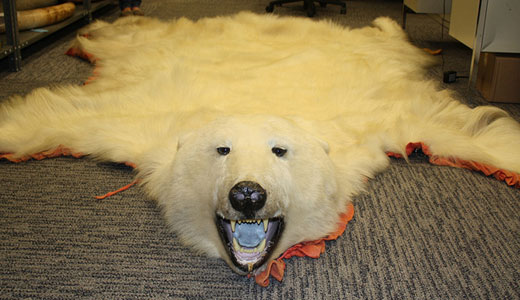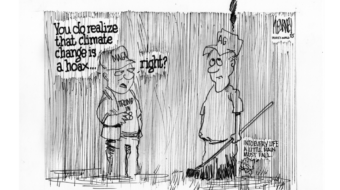
Environmentalists, looking to help polar bears already affected by global warming, are pushing for an international ban on the legal trade in polar bear items, which threatens their already-dwindling population.
Climate change has caused Arctic sea ice to hit a record low, drastically disrupting the natural habitat of polar bears. But the animals are also vulnerable to killings, due to the international polar bear trade, which harvests the bears’ furs and skins (hundreds of which are traded annually). The trade remains legal under the Convention on International Trade in Endangered Species (CITES). But activists with the International Fund for Animal Welfare and the Humane Society International are hoping to change that.
These organizations, backed by the support of other nonprofit groups and activists, are calling for the animals’ status to be changed from appendix two to appendix one under the Convention, which would designate it officially banned, stamping out the commercial trade of polar bear parts.
“We cannot sit on the sidelines and accept the extinction of these iconic and magnificent creatures,” said IFAW D.C. office director Jeff Flocken. “The government should be doing everything it can to eliminate all threats to polar bears. The U.S. could help prevent the deaths of hundreds of polar bears killed needlessly for the commercial market.”
“Polar bears are facing so many threats right now,” added Roger Schlikeisen, president of Defenders of Wildlife, “from global warming to poaching, trophy hunting, and commercial trade, that scientists say they could vanish from the U.S. by the middle of the century. We can’t solve all of these threats right away, but we can eliminate the threat of commerical trade.”
“Polar bears are becoming more and more scarce, and that scarcity is driving up demand,” said the HSI’s Teresa Telecky. “It’s helping drive the species toward extinction.”
According to HSI and the IFAW, an estimated 6,000 polar bears were killed for the purpose of the international trade between 2001 and 2010 alone. Even worse, the entire polar bear population worldwide is believed to number no more than 20,000.
The proposal to ban the polar bear trade has been submitted, and will be voted on during March 2013 in Thailand by 176 countries during the CITES conference.
But even if activists succeed in doing away with the horrible practice and the industry that feeds on it, the vanishing ice in the Arctic still presents a significant threat to polar bears, which are totally dependent on sea ice for hunting, reproducing, and moving around. That means that people still have environmental responsibilities to live up to.
Leading climate scientist Michael Mann, director of Pennsylvania State University’s Earth System Science Center, said, “We know Arctic sea ice is declining faster than models predict. They have typically predicted this would not happen for decades, but the measurements coming in tell us it is already happening. We are decades ahead of schedule.”
Arctic foxes are also at risk from the ice shrinkage – something scientists observed back in 2008. The foxes rely on ice to avoid predators when the winter hits.
Scientist Nathan Pamperin at the department of biology and wildlife at the University of Alaska Fairbanks, noted, “With reduced access to sea ice, it is possible that, in the years when foxes would normally travel on the ice, they may face tougher conditions on land, and possibly lower survival.”
The issue could also push foxes into human settlements, “increasing the potential for human-wildlife conflicts.” That might present a problem similar to the urbanization of coyotes in cities in the U.S., which is caused by food and habitat depletion.
And the dilemma will affect people more directly, as well:
“Island nations that have considered the possibility of evacuation at some point may have to be contending those decisions within a matter of a decade or so,” Mann remarked. “Thousands of years of culture are at risk of disappearing as the populations of vulnerable island states have no place to go.
“For these people, current sea levels are already representative of dangerous anthropogenic interference, because they will lose their world far before the rest of us suffer.”
Photo: A polar bear skin seized from New Jersey by the U.S. Fish and Wildlife Service. Bill Butcher/USFWS & Flickr










